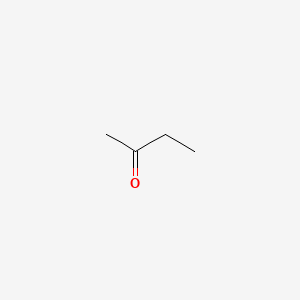| MeSH term | MeSH ID | Detail |
|---|---|---|
| Adenocarcinoma | D000230 | 166 associated lipids |
| Dermatitis, Contact | D003877 | 59 associated lipids |
| Pancreatic Neoplasms | D010190 | 77 associated lipids |
| Body Weight | D001835 | 333 associated lipids |
| Edema | D004487 | 152 associated lipids |
| Occupational Diseases | D009784 | 42 associated lipids |
| Peripheral Nervous System Diseases | D010523 | 33 associated lipids |
| Nervous System Diseases | D009422 | 37 associated lipids |
| Epilepsy | D004827 | 35 associated lipids |
| Neuromuscular Diseases | D009468 | 10 associated lipids |
2-butanone
2-butanone is a lipid of Fatty Acyls (FA) class.
Cross Reference
There are no associated biomedical information in the current reference collection.
Current reference collection contains 3166 references associated with 2-butanone in LipidPedia. Due to lack of full text of references or no associated biomedical terms are recognized in our current text-mining method, we cannot extract any biomedical terms related to diseases, pathways, locations, functions, genes, lipids, and animal models from the associated reference collection.
Users can download the reference list at the bottom of this page and read the reference manually to find out biomedical information.
Here are additional resources we collected from PubChem and MeSH for 2-butanone
Possible diseases from mapped MeSH terms on references
We collected disease MeSH terms mapped to the references associated with 2-butanone
PubChem Associated disorders and diseases
PubChem Biomolecular Interactions and Pathways
NCBI Entrez Crosslinks
All references with 2-butanone
Download all related citations| Authors | Title | Published | Journal | PubMed Link |
|---|---|---|---|---|
| Prokopczyk B et al. | Identification of tobacco-specific carcinogen in the cervical mucus of smokers and nonsmokers. | 1997 | J. Natl. Cancer Inst. | pmid:9196253 |
| Pillai MR et al. | Some observations on the instability of 99mTc-complexes of propylene amine oxime (PnAO). | 1994 | Nucl. Med. Biol. | pmid:9234355 |
| Yang H et al. | The enantiomeric purity of alcohols formed by enzymatic reduction of ketones can be improved by optimisation of the temperature and by using a high co-substrate concentration. | 1997 | Biochim. Biophys. Acta | pmid:9271250 |
| Semba H and Sakano K | A para-site-specific hydroxylation of aromatic compounds by Mycobacterium sp. strain 12523: stabilization of the hydroxylation activity. | 1997 | Appl. Microbiol. Biotechnol. | pmid:9299785 |
| Mitran E et al. | Neurotoxicity associated with occupational exposure to acetone, methyl ethyl ketone, and cyclohexanone. | 1997 | Environ. Res. | pmid:9311545 |
| Mathews JM et al. | Do endogenous volatile organic chemicals measured in breath reflect and maintain CYP2E1 levels in vivo? | 1997 | Toxicol. Appl. Pharmacol. | pmid:9344893 |
| Mortensen B et al. | Metabolic interaction of n-hexane and methyl ethyl ketone in vitro in a head space rat liver S9 vial equilibration system. | 1998 | Pharmacol. Toxicol. | pmid:9498234 |
| Zhao W et al. | Relationship between 2,5-hexanedione concentrations in nerve, serum, and urine alone or under co-treatment with different doses of methyl ethyl ketone, acetone, and toluene. | 1998 | Neurochem. Res. | pmid:9572672 |
| Zhao W et al. | Effects of methyl ethyl ketone, acetone, or toluene coadministration on 2,5-hexanedione concentration in the sciatic nerve, serum, and urine of rats. | 1998 | Int Arch Occup Environ Health | pmid:9638479 |
| Binding N et al. | Simultaneous determination of airborne acetaldehyde, acetone, 2-butanone, and cyclohexanone using sampling tubes with 2,4-dinitrophenylhydrazine-coated solid sorbent. | 1998 | Toxicol. Lett. | pmid:9820680 |
